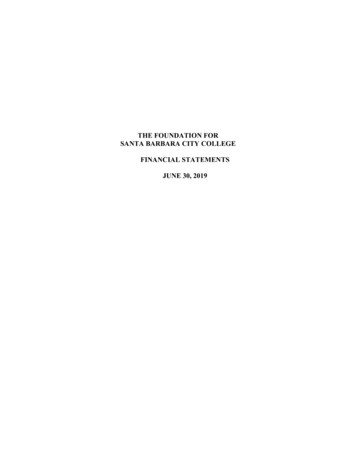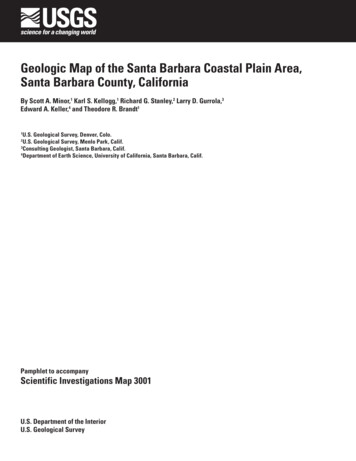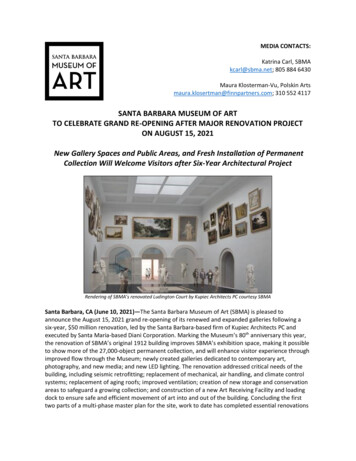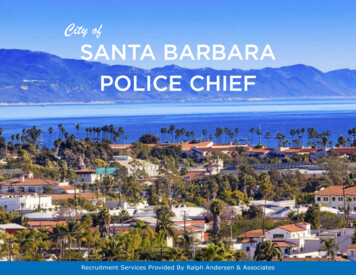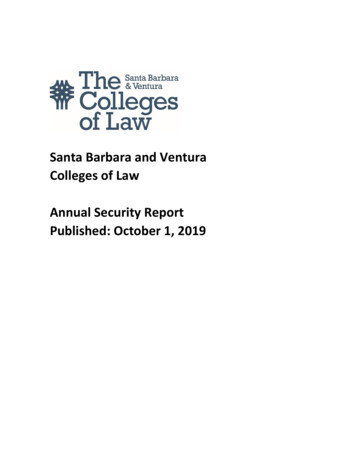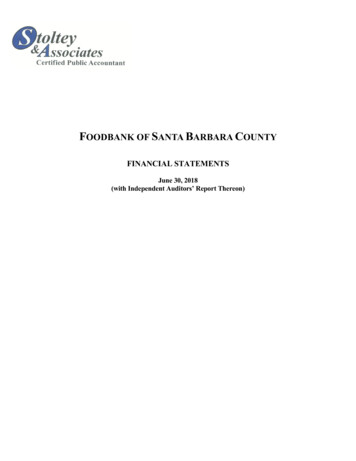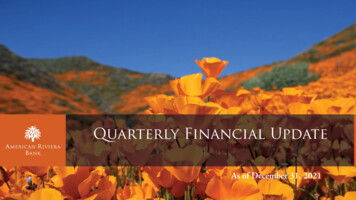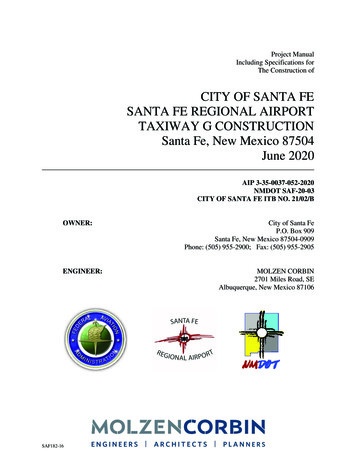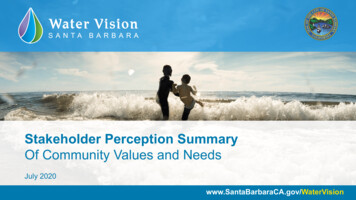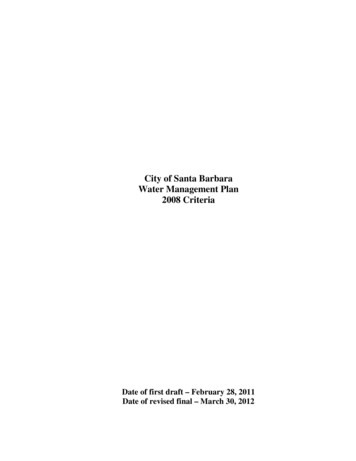
Transcription
City of Santa BarbaraWater Management Plan2008 CriteriaDate of first draft – February 28, 2011Date of revised final – March 30, 2012
IndexPageSection 1:Description of the City .Section 2:Inventory of Water Resources .Section 3:Best Management Practices for Urban Contractors .Attachment ACity Facilities Map .Attachment BCity Water-Related Rules and Regulations .Attachment CCity Rate Table & Sample Water Bills .Attachment DCity Water Shortage Plan .Attachment EMap of City Groundwater Facilities.Attachment FAnnual Potable Water Quality Report .Attachment GWater Conservation Program Description .2
Section 1: Description of the CityCity Name:City of Santa BarbaraContact Name:Alison JordanTitle: Water Conservation CoordinatorTelephone:(805) 564-5574E-mail: ajordan@SantaBarbaraCA.govWeb Address www.SantaBarbaraCA.gov/waterA. History1. Date City formed: April 9, 1850Original size (acres): 8,000Date of first Reclamation contract: 1953Current year (last complete calendar year): 20102. Current size, population, and irrigated acres(enter data year)12,636Size (acres)95,129Population served3. Water supplies received in current year (2010)Water SourceAF6,887Federal urban water734State water0Other Wholesaler3,222Local surface water (Gibraltar/DevilsCanyon)2,481City ground water (incl. Mission Tunnelinfiltration)0Banked water0Transferred water146Recycled water (includes only the actualrecycled water component, not potableblend water)1NAOther13,470Total1The City blends potable water into the recycled water to maintain water quality. The supply amountshown for recycled water includes only that water that is actually supplied from the water recyclingfacility. This is to avoid double counting the potable blend water that is counted as part of the potablewater supplies received.3
4.Annual entitlement under each right and/or contractAFSourceContract #8,277 AFY Cachuma175r-1802RReclamation UrbanProjectSWPGibraltar ReservoirMission TunnelDevils Canyon CreekGroundwater3,300 AFYState Waterfacilities 5,000AFYSanta YnezRiverHistoricalaverageinfiltrationof 1,125AFYHistoricaldiversionsrange from 0to 557 AFYHistoricalpumping ofapprox.1,000 AFYInfiltration ofgroundwaterto MissionTunnelSanta YnezRiverWater SupplyAgreementbetween Cityand CCWA,dated 9-3-1991(CityAgreement No.16,162)Per Gin ChowJudgment,currentoperationpursuant toUpper SantaYnez RiverOperationsAgreement(CityAgreement No.15,070)Pre-1914 waterrightPre-1914 waterrightStorage Units HistoricalNo. 1 & No. 3 pumping recordof the SantaBarbarabasin; andFoothill basinAvailability period(s)Continuous, subject toCachuma Project operatingagreementsContinuous, subject toavailability of SWPdeliveriesAs available, as providedin USYROA.ContinuousTypically available onlyduring winterManaged conjunctively;lower pumping during wetyears; maximum pumpingduring severe droughts5. Anticipated land-use changesIn December 2011, the City adopted a General Plan update that included evaluation of land use changesand projected growth. The service area is primarily residential and commercial uses are predominantlyin the retail, food, and tourist industries. The City is largely ‘built-out’ and limited new development istrending toward higher density, mixed-use projects.4
B. Location and FacilitiesSee Attachment A for points of delivery, conveyance system, storage facilities, wells, and water qualitymonitoring locations1. Incoming flow locations and measurement methodsLocation NamePhysical LocationCater InfluentMeter - CaterTreatment Plant(from LakeCachuma &Gibraltar Reservoir)Sheffield PumpStation (from SouthCoast Conduit)La Vista Reservoir(from Goleta WaterDistrict)Los Robles WellStation(groundwaterpumping)Hope Avenue WellStation(groundwaterpumping)San Roque ParkWell Station(groundwaterpumping)Currently inactiveflow inputs due torehabilitation/construction work:1150 San Roque Road (upstream ofReservoir #13 on Attachment A)Type of MeasurementDevice36” Venturi MeterAccuracy /- 1%accuracyAdjacent to 2375 Foothill Road (eastof Reservoir #6 on Attachment A)24” Venturi Meter /- 1%accuracyAdjacent to 1020 La Vista Road(Reservoir #8 on Attachment A)6” Magnetic FlowMeter /- 1%accuracyVia Diego at Via Rosa(Well #3 on Attachment A)6” Magnetic FlowMeter /- 1%accuracyHope Avenue, north of CalleEsperanza(Well #1 on Attachment A)6” Magnetic FlowMeter /- 1%accuracy165 Canon Drive(Well #2 on Attachment A)6” Magnetic FlowMeter /- 1%accuracyOrtega Groundwater Treatment PlantCorporation Yard Well StationCity Hall Well StationOrtega Park Well StationVera Cruz Park Well StationNANA2. Current year Urban Distribution System (Miles of Pipe – Total is 335 miles of pipe)Cast IronPVCDuctile IronSteelACOther14110048261285
3. Storage facilities (tanks, reservoirs, regulating reservoirs)NameTypeCapacity (AF)Lake Cachuma (regional) Raw water storage186,000Gibraltar ReservoirRaw water storage5,250Reservoir #1Treated water storage3.5Reservoir #2Treated water storage4.4Cater ReservoirTreated water storage15.5East ReservoirTreated water storage3.1El Cielito ReservoirTreated water storage3.1Escondido Reservoir (out Treated water storage13.5of service)Hope ReservoirTreated water storage3.1La Mesa ReservoirTreated water storage4.6La Vista ReservoirTreated water storage7.1Sheffield Reservoirs (2)Treated water storage40.0Skofield ReservoirTreated water storage1.8Tunnel Road ReservoirTreated water storage3.1Vic Trace ReservoirTreated water storage30.14. Restrictions on water source(s)SourceRestrictionGibraltarPeriodic turbidity problemsReservoirfollowing precipitationeventsAll surface water Manage supplies inpreparation for potentialsustained droughtDistribution or tributionDistributionCause of RestrictionEffect on OperationsWater qualityTemporarily reduce ordegradationsuspend deliveries fromGibraltarTypical 5-yearShift operations to increasecritical droughtdeliveries of State Waterperiod reducesand increase groundwatersurface waterpumpingdeliveries5. Proposed changes or additions to facilities and operations for the next 5 years Ongoing Water Main Replacement Program: minimizes water loss due to breaks and avoids abacklog of deferred maintenance in the distribution system Capital Maintenance Program on distribution system pump stations: pump & motorreplacements and telemetry upgrades Construct Advanced Treatment Project at Cater Water Treatment Plant: aimed at meeting morestringent Disinfection Byproduct Rules; involves addition of ozone treatment at the front end ofthe water treatment plant to reduce the amount of dissolved organic material in raw water Rehabilitate the Ortega Groundwater Treatment Plant serving Storage Unit No. 1 wells: updatestreatment technology to address high levels of sulfides in groundwater Construct new well to replace Corporation Yard Well; replacement for failed well Implement “Pass Through” operations mode under the Upper Santa Ynez River OperationsAgreement: initiate a Warren Act contract to provide for storage of the City’s Gibraltar Water inLake Cachuma, pursuant to the 1989 Upper Santa Ynez River Operations Agreement; operationsunder the agreement to date have not involved storage of water in Lake Cachuma.6
Investigate water banking opportunities to use available State Water Project deliveries toimprove reliability during severe drought: aims to implement conjunctive management of theCity’s State Water Project supplies by developing agreements to store available water ingroundwater banks for later use during dry periods.C. Topography and Soils1. Topography of the City and its impact on water operations and managementThe City borders the Pacific Ocean to the south and extends northward into the foothills of the SantaYnez Mountains. Elevation ranges from sea level to approximately 1100 feet. The City’s distributionsystem is designed to be primarily gravity fed, with some exceptions. In the case of those exceptions,pumping stations are used instead.D. Climate1. General climate of the City service areaAvg Precip.Avg Temp (F)Avg Max TempAvg Min TempTotal ETo 1.672.752.63.1Weather station ID CIMIS Station #107Data period: YearAverage wind velocityAverage annual frost-free days:2.9 nnualTotal/Avg19.059.469.650.843.8to Year 20103602. Impact of microclimates on water management within the service areaNoneE. Natural and Cultural Resources1. Natural resource areas within the service areaNameEstimated AcresPacific OceanApprox. 200 acresSycamore, Mission, andArroyo Burro CreeksVisual ResourcesDescriptionBeach areas and related ocean resources alongapproximately 7 miles of coastline on theSanta Barbara ChannelCreeks draining three south slopingwatersheds of the Santa Ynez MountainsGenerally scenic areas including ocean andmountain viewsApprox. 250 acresNA7
2. Description of City management of these resources in the past or presentThe Water Resources Division is not directly responsible for the management of natural, cultural, orrecreational resources. Other City departments administer these efforts. For example, watershedmanagement is coordinated via the Creeks Division within the Parks & Recreation Department.3. Recreational and/or cultural resources areas within the service areaNameEstimated AcresDescriptionCity Parks System1,88556 City parks, including a regional park,passive open spaces, neighborhood parks,sports fields, and beach parksSanta Barbara City90Local and regional sports facilitiesCollegeSanta Barbara SchoolCitywideNeighborhood sports fields and gymsDistrictDowntown Cultural Arts250Various venues supporting a variety of cultural& Entertainment Districtactivities, including theater, film, musicalperformances, and lecturesSanta Barbara Mission25Established in 1786 by Father Junipero SerraHistoric855El Pueblo Viejo, Lower Riviera SpecialDesign/PreservationDesign District, Riviera Campus DesignDistrictsDistrict, Brinkerhoff Avenue LandmarkDistrictF. Operating Rules and Regulations1. Operating rules and regulationsSee Attachment B, City Rules and Regulations (water related)2. Policies on water transfers by the City and its customersIn most all cases, the City Water Resources Division is the water purveyor for properties within the Citylimits. In some cases, agreements for service of City areas by neighboring agencies have beendeveloped to provide for cost effective service. An example is the 1982 Overlap Agreement betweenthe City and the neighboring Goleta Water District by which the City and District cooperate to exchangewater as needed to provide service in an area of numerous small pockets of unincorporated land. Waterexchanges at the retail and utility level are reconciled monthly to keep each agency whole. In additionto formal agreements, the City works cooperatively with neighboring agencies to provide for service toisolated pockets of customers that cannot be practically served by the jurisdiction within which theproperty lies. To a limited extent, groundwater is pumped by individual property owners for on-site use.G. Water Measurement, Pricing, and Billing1. Urban Customersa. Total number of connections26,504b. Total number of metered connections 26,504c. Total number of connections not billed by quantity80
d. Percentage of water that was measured at delivery point100%e. Percentage of delivered water that was billed by quantity91%f. Measurement device tableMeter Size and Type5/8-3/4” (PositiveNumberAccuracy( /percentage)ReadingFrequency(Days) aintenance Frequency(Months)Replacement being considered inconjunction with potential AMR program5-year meter replacement program hasjust been completed on all these meters, toimprove reading accuracy at low flowsand more accurately measure meteredsales. Maintenance is on an as neededbasis, per meter reading exception reports.20,8693,901 /-1.5%301” (Velocity/Single Jet)787 /- 1.5%301 ½” (Velocity/Single Jet)883 /- 1.5%302” (Velocity/Single Jet)33 /- 1.5%303” (Velocity/Single Jet)16 /- 1.5%304” (Velocity/Single Jet)5 /- 1.5%306” (Velocity/Single Jet)1 /- 1.5%308” (Velocity/Single Jet)1 /- 1.5%3010” (Velocity/Single Jet)8 /- 1.5%30Compound (Combination)0Turbo0Other (define)26,504TotalSeveral small scale AMR pilot projects have been completed or are underway to test effectiveness.Handheld computers have been upgraded and currently possess remote-read capability. Metermanufacturer and model will be selected based on results of pilot studies. Frequency of metercalibration will be based on manufacturer’s recommendations.2. Urban Customersa. Current year urban water charges – including rate structures and billing frequencySee Attachment C, Water Rate Table & Sample City Water Bills, for current year table of unit ratesand allotments by customer class and sample water bill.b. Annual charges collected from customers (current year data)Fixed ChargesCharges ( /unit)(Prorated for FY 10 & FY 11 to reflect CY 2010) 12.13 18.23 30.34 60.67 97.10 194.19 303.42 606.84 970.13 1,395.72Out-of-City SurchargesCharge units(Meter Size)5/8”3/4”1”1 ½"2"3"4"6"8"10"Total:9Units billed during year(Meters)19,4561,4133,9017878833316131126,504 collected( times units) 2,832,015 309,108 1,420,276 572,967 1,028,872 76,899 58,257 94,667 11,642 16,749 76,669 6,498,121
Volumetric chargesCharges( unit)Ranges from 1.45/HCF to5.16/HCF, with out-of-Citycustomers subject to 30%surcharge (see rate andblock allocationitemization in AttachmentC)Charge unitsHCFUnits billed during year(HCF)5,126,647 collected( times units) 21,009,044c. Water-use data accounting proceduresSee Attachment C, Water Rate Table & Sample City Water Bills. Metered sales reports areprepared semi-annually to track the metered sales ratio (ratio of metered customer sales toproduced water). The City has recently completed implementation of new utility billing systemsoftware allowing long-term storage of billing and consumption data. Monthly revenue istracked against the average of current and prior month production (to reflect lag in sales revenuecompared to production).H. Water Shortage Allocation Policies1. Current year water shortage policies or shortage response plan - specifying how reduced watersupplies are allocatedThe water supply condition is a “normal” year where supplies are adequate for all reasonableuses. However, customers are at all times urged to take advantage of many conservationopportunities and are motivated by an inclining block rate structure. Under drought conditions,rates are increased and allotments reduced to reinforce the need for additional extraordinarycutback in use.See Attachment D, City Water Shortage Plan2. Current year policies that address wasteful use of water and enforcement methodsSee Section 4.A.1-1.110
Section 2: Inventory of Water ResourcesA. Surface Water Supply1. Acre-foot amounts of surface water delivered to the water purveyor by each of the purveyor’ssources (See Water Inventory Table, Table 1 for monthly data)Deliveries from Lake Cachuma:Deliveries from Gibraltar Reservoir:Deliveries of State Water:Total Surface Water Deliveries:6,887 AF3,222 AF734 AF10,843 AF2. Amount of water delivered to the City by each of the City’s sources for the last 10 yearsSee Water Inventory Tables, Table 8B. Ground Water Supply1. Acre-foot amounts of ground water pumped and delivered by the City (Calendar Year 2010)Pumped Groundwater Deliveries:1,191 AFMission Tunnel Infiltration:1,290 AFTotal Groundwater Deliveries:2,481 AF2. Ground water basin(s) that underlies the service areaNameSize (Square Miles)Storage Unit No. 1, SB Basin7.0Storage Unit No. 3, SB Basin2.1Foothill Basin4.5Usable Capacity (AF)10,0007,5006,000Safe Yield (AF/Y)8001009003. Map of City-operated wells and managed ground water recharge areasSee Attachment E, City Map of Groundwater Facilities4. Description of conjunctive use of surface and ground waterThe storage capacities of the City’s groundwater basins are limited, but groundwater is animportant component of the overall water supply plan. Conjunctive use consists of pumping ator below the perennial basin yields in normal years and increased pumping during extended dryperiods to offset reductions in surface water supplies. The design drought has been a 5-yearperiod of below average rainfall, resulting in reduction in deliveries from Lake Cachuma andGibraltar Reservoir. Groundwater pumping of up to 4,150 AFY from Storage Unit No. 1 and theFoothill Basin is used to maintain adequate supplies, based on an assumed usable storage volumeof 16,000 AF. Desalination could be used in the event of prolonged drought, and for recovery ofgroundwater levels following drought.5. Ground Water Management PlanThe City has managed groundwater pursuant to the adopted Long-Term Water SupplyManagement Program (1994) and does not have a formal groundwater management plan. The1994 plan has recently been updated and includes a more comprehensive approach togroundwater management based on a three-year project with USGS to update modeling of the11
City’s basins. Particular attention is being paid to optimal strategies for managing seawaterintrusion and an existing two-dimensional model is being updated to a three-dimensional modelto more accurately model intrusion impacts. The City’s 2011 Long Term Water Supply Plan isposted on line at: /Documents.htm. TheCity is also working with the California Department of Water Resources to post groundwaterlevel measurements under the California Statewide Groundwater Elevation Monitoring(CASGEM) Online System. The monitoring plan is expected to be complete during the currentfiscal year.6. Ground Water Banking PlanThe City’s groundwater banking plan is equivalent to the conjunctive management programdescribed in Item 4 above. In addition, regional banking opportunities are being investigated toaugment the limited storage and recharge capacity of local basins, and to optimize the use ofavailable Table A deliveries from the State Water Project.C. Other Water Supplies1. “Other” water used as part of the water supplyState Water Project: The City holds a Table A amount of 3,300 AFY, which is administered bythe Central Coast Water Authority. A minimum delivery amount of approximately 600 AFY isdefined in an “Exchange Agreement” with the Santa Ynez River Water Conservation District,Improvement District No. 1. Deliveries in excess of that amount are taken as needed and asavailable. Calendar year 2010 deliveries were 734 AF.Recycled Water: The City has constructed two phases of its Water Reclamation Project, servinga connected demand of 800 AFY. Most usage is for irrigation of parks, playgrounds, schools,and golf courses. A number of public facilities also use recycled water for toilet flushing.Blending of potable water is used to meet targeted levels of mineral content. Alternatives toblending are being investigated in the event water supply constraints preclude use of potablewater blending.Desalination: During the severe drought of 1987-1991, the City constructed a seawaterdesalination facility. The current capacity is 3,125 AFY, though it has not been needed in recentyears due to adequate surface water supplies and reduced demand. It is available for use ifneeded in future droughts and is retained in the City’s water supply plan for that purpose.D. Source Water Quality Monitoring Practices1. Potable Water Quality (Urban only)See Attachment F – City Annual Water Quality Report12
E. Water Uses within the City1.Urban use by customer type in current yearCustomer TypeNumber Institutional (included with Commercial)Potable 26,50411,769Actual M&I Water Sales:245Process Water to El Estero Wastewater TP224Other Uses per Table 612,238Total Uses1,232Unaccounted Water13,470Total Water Supply9%Percent Unaccounted WaterNotes:1A portion of the potable water supply is used as blend water to maintain water quality in the recycledwater system. This is a no cost transfer because the two systems are operated by the same fund. Blendwater is included in the metered usage by the Recycled customer class and the wastewater treatmentplant process water usage.2 Recycled water sales of 617 AF reflect aggregate readings of retail metersmeasuring water out of the recycled water distribution system. The value of 594 AF in the followingtable reflects recycled water metered into the recycled water distribution system. Variance betweenthese two numbers reflects variation in time of meter readings (end of month for production versusduring the month for retail readings) and variation between a single production meter and multiple retailmeters.2. Urban Wastewater Collection/Treatment Systems serving the service area – current yearTreatment PlantTreatment Level (1, 2, 3)AFDisposal to / usesEl Estero Wastewater3594Recycled water distributionTreatment Plant – TertiarysystemTreatment:EEWTP – Secondary27,980Pacific Ocean discharge, 1.5Effluentmiles offshoreTotal8,574Total discharged to ocean and/or saline sink7,98013
3. Ground water recharge/management in current year (Table 6)Recharge AreaMethod of RechargeAFMission CreekDischarge into Mission28Creek at South Portal ofMission Tunnel forgroundwater rechargeTotal28Method of RetrievalPumping from Storage UnitNo. 1 well field4. Transfers and exchanges into or out of the service area in current year (Table 6)From WhomTo WhomAFUseCity distribution systemNet transfers to Goleta62Inter-agency transferWater District pursuantbetween potable distributionto the 1982 Overlapsystems.Agreement5. Trades, wheeling, wet/dry year exchanges, banking or other transactions in current year (Table 6)From WhomTo WhomAFUseCentral Coast WaterLa Cumbre Mutual880Treatment and conveyanceAuthorityWater Companyof LCMWC’s State Waterthrough the City’sdistribution system; thiswater is netted out of watersupplies going into theCity’s distribution systemand is reimbursed outsidethis calculation as well.Therefore it does not show inthe Water BalanceInventory below6. Other uses of water in current yearOther UsesNAAFNA14
G. Water Accounting (Inventory)1. Water Supplies Quantified (AF)See Tables 1, 2, & 32. Water Used Quantified (AF)See Tables 4 & 63. Overall Water InventorySee Table 615
Section 3: Best Management Practices for Urban ContractorsA. Urban BMPsRequirements for Documenting BMP Implementation:1. Utilities Operations1.1 Operations Practices1) Conservation coordinatorContact information:Alison Jordan, Water Conservation CoordinatorEmail: ajordan@SantaBarbaraCA.govPh: (805) 564-5574This position is responsible for implementing the tasks identified in Section A.1.2) Water waste preventiona) City Ordinance No. 4558, adopted on February 1989, prohibits the waste of water defined asgutter flooding and failure to repair leaks in a timely manner.Landscape Design Standards.On August 12, 2008, the City Council adopted the revised Landscape Design Standards forWater Conservation, Resolution No. 08-083. The Landscape Design Standards were originallyadopted by resolution of the City Council on June 27, 1989. There has been much progress inirrigation technology and sustainable landscaping practices in the last 19 years; therefore, it wastime to bring the standards up to date. Chapters 14.23 and 22.80 of the Santa BarbaraMunicipal Code require projects that are subject to design review to comply with LandscapeDesign Standards.City’s New Development Project Administrative Requirements meet all the BMP requirementsfor prohibiting water waste in new development.b) City of Santa Barbara coordinates with the County of Santa Barbara on the County’slandscaping requirements for development projects within the County’s jurisdiction thatreceive City water.c) The City’s Legislative Platform includes support of water conservation related legislation.1.2 Water Loss Control1) Annually City completes the standard water audit and balance using the AWWA Water Loss softwareand will submit the completed AWWA Standard Water Audit and Water Balance worksheets in theCUWCC reporting database every reporting period.2) For each reporting period, City will keep and make available validation for any data reported.3) City will maintain in-house records of audit results, methodologies, and worksheets for eachcompleted audit period.4) City keeps records of each component analysis performed, and incorporates results into futureannual standard water balances.5) City, for the purpose of setting the Benchmark:16
a) keeps records of intervention(s) performed, including standardized reports on leakrepairs, the economic value assigned to apparent losses and to real losses, miles of system surveyedfor leaks, pressure reduction undertaken for loss reduction, infrastructure rehabilitation and renewal,volumes of water saved, and costs of intervention(s); andb) prepares a yearly summary of this information for submission to the CUWCC, during years twothrough five of implementation, unless extended by the CUWCC.1.3 Metering1) Annually the City will provide in the CUWCC reporting database confirmation that all new serviceconnections are metered and are being billed by volume of use and provide all data requested forcompliance with BMP 1.3.2) The City meters all customers and has an inclining block rate structure.3) The City will undertake a feasibility study examining incentive programs to move landscape wateruses on mixed-use meters to dedicated landscape meters.1.4 Retail Conservation Pricing1) Annually the City will provide in the CUWCC reporting database the rate structure in effect for eachcustomer class for the reporting period.2) Annually the City will provide in the CUWCC reporting database the annual revenue derivedfrom volume charges for each retail customer class, as defined in Section A. (Note: Compliancewith BMP 11 will be determined based on the City’s total revenue from all retail customer classes.)3) Annually the City will provide in the CUWCC reporting database the annual revenue derivedfrom monthly or bimonthly meter/service charges for each retail customer class, as defined inSection A.2. Education2.1 Public Information ProgramsAnnually the City will provide in the CUWCC reporting database the required reporting documentationfor the City’s Public Information Programs which include the following:Water Conservation Hotline. The Hotline handles the incoming calls for the Water ConservationProgram. Hotline staff schedule water checkups and provides administrative assistance to theConservation Program.Website. The City’s Water Conservation Programs website is www.savewatersb.org. Additionally theCity promotes the regional water conservation program website, www.sbwater.org.Water Conservation Brochures. Brochures and handouts are distributed both hard copy and via thewebsite on indoor water conservation, efficient irrigation and sustainable landscaping.Video Loan. Videos on sustainable landscaping, water conservation, efficient irrigation, and watersupply are available to the public to loan.17
Media Campaign. An annual media campaign is implemented in conjunction with the Santa BarbaraCounty Water Agency and funding from water purveyors countywide.Water Bill Message. A monthly water conservation message is printed directly on the water bill.Demonstration Gardens. The Water Conservation Program has two low-water using demonstrationgardens, at Alice Keck Park Memorial Garden in conjunction with the Parks Department and theFirescape Garden in conjunction with the Fire Department.Garden Wise Guys. Garden Wise Guys a thirty-minute television show about designing & maintaining asustainable landscape. The quarterly show is produced by City TV and funded by the Santa BarbaraCounty Water Agency, the City of Santa Barbara Public Works Department, and the Goleta WaterDistrict. It is hosted by two local landscape architects: Owen Dell and Billy Goodnick. With a uniquesense of humor, the Garden Wise Guys will give viewers the basic information they need to start makingchanges in their own yard.Water Wise Gardening for Santa Barbara County CD and Website.A free “tool” for water wise gardening —a compact disc and website of gardening information tailoredto our climate and our need for water conservation, titled "Water Wise Gardening in SB County".Available on CD or online at www.savewatersb.org or www.sbwater.org, it includes: extensive databasewith searchable information on over 1,000 water wise plants; more than 300 photos grouped into gardentours and garden galleries, all from local gardens Countywide; helpful facts, resources, and guidance ongardening design and practices; and links to other useful sustainable gardening sites.2.2 School EducationAnnually the City will provide in the CUWCC reporting dat
City of Santa Barbara Water Management Plan 2008 Criteria Date of first draft - February 28, 2011 Date of revised final - March 30, 2012 . 2 . Santa Barbara City College 90 Local and regional sports facilities Santa Barbara School District Citywide Neighborhood sports fields and gyms
